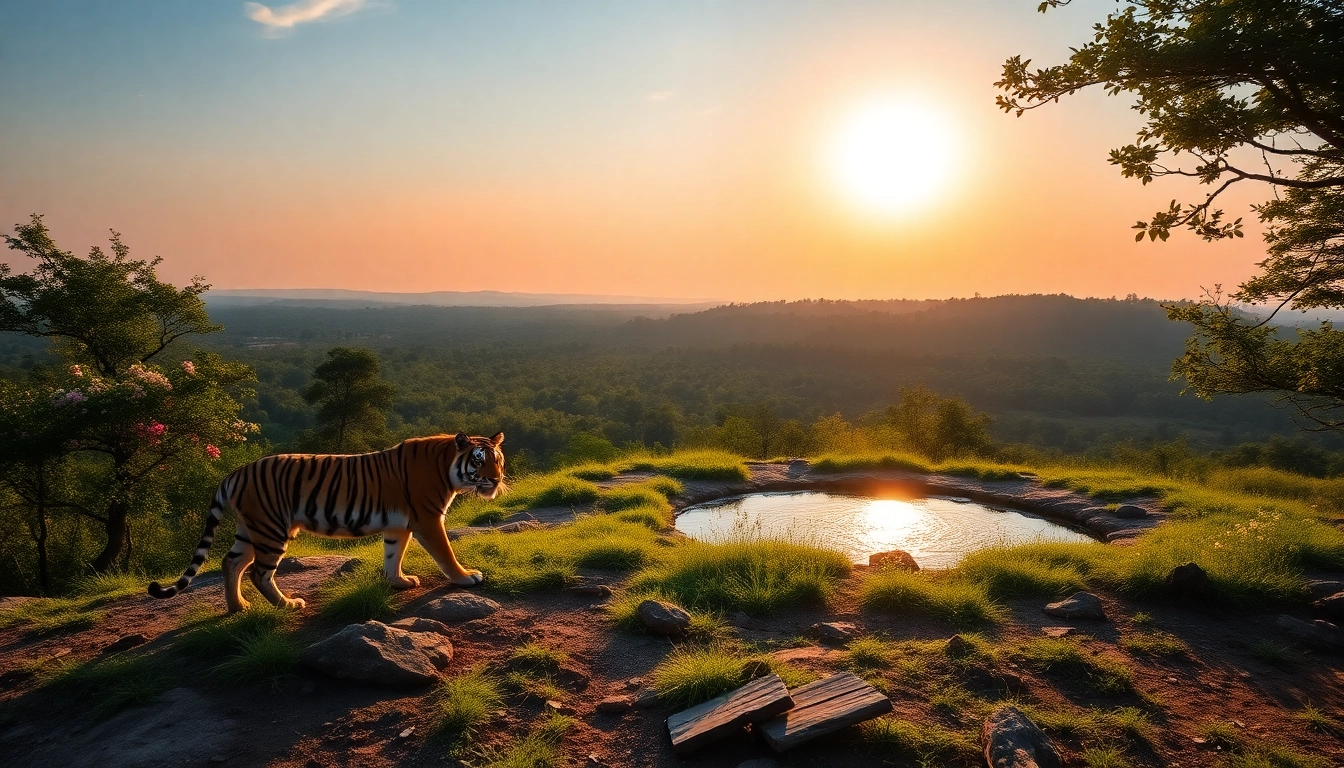Understanding the Tiger Safari Experience in India
Embarking on a tiger safari in India is an exceptional adventure that combines the thrill of wildlife spotting with the rich cultural heritage of the country. With the majestic Royal Bengal tiger being the focal point, these safaris promise not only sightings of these magnificent creatures but also an immersion into India’s diverse ecosystem. To make the most of this experience, understanding what to expect and how to prepare is crucial. Whether you are a wildlife enthusiast or a casual traveler, knowing the ins and outs of a tiger safari can enhance your journey. You can book tiger safari in India to experience this unforgettable journey.
What to Expect on a Tiger Safari
On a typical tiger safari, you will have the opportunity to venture into the heart of India’s national parks. The most popular parks include Ranthambore, Kanha, Bandhavgarh, and Corbett, each offering unique landscapes and rich biodiversity. Expect early morning or late afternoon game drives when wildlife is most active. The anticipation of spotting tigers, along with other wildlife like leopards, deer, and various bird species, adds to the adrenaline rush.
Comfort is also an essential aspect of a tiger safari. From luxury lodges to eco-friendly camps, accommodations vary widely, enhancing the safari experience. Each package typically includes guided tours with experienced naturalists who share invaluable insights about the flora and fauna of the region.
Safety Tips for Safari Tourists
Safety is paramount during a tiger safari. Tourists must adhere strictly to guidelines provided by their tour operators and park authorities. Here are some crucial tips:
- Always stay inside the vehicle during sightings, as approaching wildlife can be dangerous.
- Keep noise levels low to avoid disturbing the animals.
- Do not feed or attempt to touch any wildlife.
- Wear comfortable attire and bring binoculars for a better viewing experience.
- Stay hydrated and carry essentials like sunscreen and insect repellent.
Choosing the Right Time to Visit
The timing of your safari can significantly affect your experience. The best time for tiger safaris generally falls between October and June, with peak seasons occurring during the cooler months of November to February. However, different parks have varied peak times, and it’s wise to research specific locations for optimal sightings.
During these months, wildlife is more active due to the favorable weather, increasing chances of spotting tigers and other animals. Furthermore, the dry season leads to dwindling water sources, driving animals closer to watering holes and making them easier to spot.
Best Locations to Book Tiger Safari in India
India has several premier national parks and wildlife sanctuaries, each offering distinct features and experiences for those looking to book a tiger safari. The following are some of the top destinations renowned for tiger sightings:
Top National Parks for Tiger Sightings
1. Ranthambore National Park: Located in Rajasthan, this park is famous for its high tiger density and ancient ruins. It provides excellent viewing opportunities in the dry months, especially around lakes.
2. Kanha National Park: Known for its stunning landscapes, Kanha offers a cinematic experience with dense forests and open meadows. It’s also home to a variety of wildlife, making it a photographer’s paradise.
3. Bandhavgarh National Park: This park boasts a high population of tigers and a significant historical background with its ancient fort. It is known for one of the highest tiger densities in India.
4. Corbett National Park: As the first national park in India, Corbett is famous for its unique landscape and rich biodiversity. It offers a combination of mountainous terrain and serene lakes.
5. Bandipur National Park: Nestled in Karnataka, it is part of the Nilgiri Biosphere Reserve and is known for its unique conservation efforts, making it an excellent spot for eco-conscious travelers.
Accessibility and Travel Tips
While each national park is accessible through various modes of transport, it’s essential to plan your journey. Most parks have nearby airports or railway stations, and many tour operators offer shuttle services. Consider the following travel tips:
- Book transportation in advance, especially during peak seasons.
- Research local accommodations that align with your safari package.
- Ensure you have the necessary permits required for the parks.
- Familiarize yourself with local customs and etiquette.
Unique Features of Each Park
Understanding the unique characteristics of each park can further enrich your safari experience:
– Ranthambore: Offers a chance to see tigers amidst historical fort ruins, providing breathtaking backdrops for photography.
– Kanha: Apart from tigers, it’s renowned for the swamp deer and exquisite flora.
– Bandhavgarh: Features different terrains, which host a varied range of wildlife species, ideal for diverse wildlife photography.
– Corbett: Famous for its birdwatching opportunities alongside tiger sightings.
– Bandipur: Known for successful conservation stories, best showcasing a variety of ecosystems.
How to Book the Perfect Tiger Safari Package
Booking a tiger safari involves careful consideration of various factors to ensure a fulfilling experience. Here are steps to guide you in arranging the perfect safari package:
Comparing Tour Operators and Packages
When looking to book a tiger safari, it’s crucial to compare several tour operators. Pay attention to customer reviews and ratings to gauge the quality of service. It’s also beneficial to directly contact operators for tailored packages that suit your specific needs.
Look out for operators who are affiliated with conservation programs or sustainable practices. These operators often provide a deeper understanding of wildlife protection and engage in responsible tourism.
What Inclusions to Look For
Ensure that your package includes essential components for a seamless experience:
- Accommodation in or near the national park.
- Daily game drives with experienced guides.
- All necessary permits and entrance fees.
- Meals, especially if you’re opting for multi-day packages.
- Transportation, including airport pickups and drops.
Customizing Your Safari Experience
The flexibility of customizing your safari experience can significantly enhance your adventure. Consider adding:
- Private guided tours for a more personalized experience.
- Photography-focused safaris, with dedicated slots for shooting wildlife.
- Cultural excursions into nearby villages to learn about local communities and conservation efforts.
Cost Factors for Tiger Safaris in India
Understanding the costs involved helps in planning your safari effectively. Here’s an overview of the factors that influence pricing:
Average Pricing for Safari Packages
The price of tiger safari packages can vary widely depending on multiple factors such as season, park, accommodation, and duration. Generally, expect to pay anywhere from $200 to $500 per person per day. Luxury safaris can exceed expectations, ranging from $600 upwards per day.
Budget-conscious travelers may find group tours to be more cost-effective, while private tours cater to those seeking exclusivity and tailored experiences.
Seasonal Discounts and Offers
Many tour operators provide discounts during the off-peak season (June to September) to attract visitors. Sign up for newsletters or alerts from reputable tour companies to stay updated on special deals. Additionally, advanced bookings sometimes qualify for a discount, so planning ahead can save costs.
Additional Expenses to Consider
While the package may cover many costs, be prepared for additional expenses such as:
- Travel insurance for peace of mind.
- Souvenirs and local crafts.
- Tips for guides and drivers, typically 10-15% of the package cost.
- Personal expenses like drinks or meals outside of the package.
Conservation Efforts and Their Importance
Tiger safaris in India are not just about sightings; they play a crucial role in wildlife conservation and local community support. Understanding this aspect can enhance your safari experience significantly.
How Tiger Safaris Support Wildlife Conservation
Funds generated from tiger safaris contribute to habitat protection, anti-poaching initiatives, and wildlife rehabilitation programs. Many national parks are involved in specific conservation projects aimed at increasing the population of tigers and preserving their natural habitat. Being a tourist in these areas indirectly supports these ongoing efforts.
Working with Ethical Tour Operators
Choosing eco-conscious and ethical tour operators is critical for sustainable tourism. These operators typically reinvest a portion of their profits back into conservation projects, ensuring that your travel habits have a positive impact on the environment and local ecosystems.
Impact of Tourism on Local Communities
Tourism associated with tiger safaris creates employment opportunities for local communities, fostering a sense of ownership over wildlife conservation. However, mindful tourism is necessary to ensure that the benefits are distributed fairly and do not negatively impact the cultural and social structures of these communities.
By engaging with local communities through cultural experiences, tourists can learn about traditional lifestyles and the importance of wildlife preservation. It’s a reciprocal relationship where both tourists and locals can benefit from shared experiences dedicated to safeguarding nature and its majestic inhabitants.



